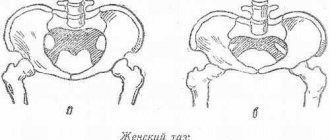The essence of the diet for pregnant women.
During the first trimester of pregnancy, the formation of the main organs and systems begins - the brain, spine, heart, blood circulation, therefore during this period the main element of the diet during pregnancy is protein.
The body should receive at least 1.5 g of protein per 1 kilogram of weight every day. If you wish, you can eat spicy and salty dishes (herring, caviar, sauerkraut, pickles). A strong desire to eat such a product arises due to insufficient secretion of gastric juice with a new hormonal regime. In most cases, non-standard food preferences disappear closer to the third or fourth month of pregnancy.
https://www.youtube.com/watch?v=ytadvertiseru
During pregnancy, it is very important to avoid deficiencies of folic acid, zinc, copper and selenium, as these substances reduce the risk of congenital pathologies. And vitamins C and B serve to reduce toxicosis. Iodine and cobalt are needed to maintain good health and help in the formation of the child’s thyroid gland.
By the second trimester, a pregnant woman's appetite often increases: more nutrients are needed for the growth of the baby and placenta. At this stage of pregnancy, the diet should contain a sufficient amount of products that would ensure the intake of protein in the body in the amount of 2 g per 1 kg of weight. In addition, at this time, a pregnant woman needs more vitamins and microelements (iron, vitamin B12, folic acid) and they are better absorbed.
As the child grows, the pregnant woman's weight also increases. Normal gain is approximately 1-1.5 kilograms per month. It is imperative to monitor your weight: just because you are pregnant does not mean that you need to eat for two. In the first trimester, the calorie content of the diet should be a maximum of 1800 kcal, in the second - 2000-2200 kcal, in the third - 2200-2400 kcal. If at the beginning of pregnancy you are overweight (BMI {amp}gt; 25), then you need to reduce the fat content in the diet to 50-60 grams per day.
Ca, P, vitamins A and D are necessary for the formation of bones, skin, mucous membranes and the retina of the child’s eyes. Cr, Zn and B vitamins help in weight control and reduce the risk of diabetes in pregnant women.
In the third trimester, fat depots are formed in the body of the pregnant woman and the child—clumps of nutrients needed during childbirth and for full lactation. At this time, the pregnant woman's diet should contain more carbohydrates, as they replenish the supply of glycogen in the liver and body muscles, as well as in the placenta and uterine muscles.
During the first trimester of pregnancy, the formation of the main organs and systems begins - the brain, spine, heart, blood circulation, therefore during this period the main element of the diet during pregnancy is protein. The body should receive at least 1.5 g of protein per 1 kilogram of weight every day.
As the child grows, the pregnant woman's weight also increases. Normal gain is approximately 1-1.5 kilograms per month. It is imperative to monitor your weight: just because you are pregnant does not mean that you need to eat for two. In the first trimester, the calorie content of the diet should be a maximum of 1800 kcal, in the second – 2000–2200 kcal, in the third – kcal. If at the beginning of pregnancy you are overweight (BMI {amp}gt; 25), then you need to reduce the fat content in the diet by a few grams per day.
In the third trimester, fat depots are formed in the body of the pregnant woman and the child - clots of nutrients needed during childbirth and for full lactation. At this time, the pregnant woman's diet should contain more carbohydrates, as they replenish the supply of glycogen in the liver and body muscles, as well as in the placenta and uterine muscles.
How to make a diet
Calories are formed by the breakdown of fats, proteins and carbohydrates. But not all calories are synthesized into subcutaneous fat. Metabolism is designed in such a way that protein compounds are not suitable for the synthesis of fat mass; this function is assigned to fats and carbohydrates.
It is not enough to calculate the daily calorie intake; it is more important to decide how much protein, fat, and carbohydrates to “feed” your body. It is important to balance your diet so that the calories extracted work for the benefit of the body and do not accumulate as excess fat under the skin.
Squirrels
Proteins are the main builders of the body: internal organs, muscle tissue, hair, nails, and regulate the protective functions of the immune system. Try to balance your diet so that 20-30% of your calories come from proteins.
Example: your calorie intake is 2000 per day, which means at least 400 kcal must be synthesized from proteins. Nutritionists recommend eating 1 g of protein per 1 kg of weight.
A large amount of proteins is found in animal products. That is why milk and meat are so important in the daily diet.
Fats
Fats are also important for the body, perform protective functions, participate in metabolism, and provide essential amino acids. Leave about 20-30% of the diet for fats, make sure that the amount is no more than 7%.
Excessive consumption of saturated and hydrogenated fats is harmful to health. And healthy fats are found in fish, milk, and nuts.
Discounts apply for any choice.
During pregnancy, a woman’s metabolism activates and the need for nutrients increases. Changes in appetite are one of the mechanisms that help conserve energy for the benefit of the developing child. The expectant mother eats more and prefers something specific, for example, vinaigrette.
Psychologists and nutritionists in pregnant women also note that the desire of expectant mothers to eat a lot is often a substitute for emotional desires. Many of them are nervous about their “interesting” situation, some tend to worry about what has not yet happened (how the birth will go, how the child will be born, etc.). In many cases, anxiety may be the cause of increased appetite.
How to switch to a diet for pregnant women.
During pregnancy, there are usually 4 standard problems that arise: morning sickness, constipation, diarrhea and heartburn. In the fight against morning sickness and heartburn, the “bite mode” helps - you need to eat little and often, drink less coffee/tea and more plain water (6-8 glasses a day). For constipation, the diet should include more salads from vegetables and fruits; for intestinal upset, increase the amount of fiber-rich whole grain bread, bananas, oatmeal, rice, bran, and oatmeal in the diet.
The diet for pregnant women should contain at least 3-4 daily servings of foods containing large amounts of calcium (hard cheese, milk, green leafy vegetables, cottage cheese) and iron (spinach, Brussels sprouts, seafood, turkey, berries, dried fruits, buckwheat). At least once a day, the diet during pregnancy should contain a product rich in folic acid (beans, lentils, green leafy vegetables, beef) and vitamin C (papaya, citrus fruits, strawberries, broccoli, tomatoes, cauliflower, bell peppers, kiwi) .
Throughout pregnancy, morning and afternoon, the diet should contain food full of proteins and fats (unsaturated). Easily digestible foods (dairy, vegetables, cereals) should be included in the diet in the afternoon. They do not burden the gastrointestinal tract and do not excite the nervous system.
During pregnancy, it is not recommended to combine solid and liquid foods in a diet - it is better not to eat the first and second in one meal. It is better to drink in the intervals between meals; 1.5 liters of liquid per day, including milk, compote and soup, will be enough.
In the fifth month of pregnancy, the diet should include more dairy and plant foods. We eat meat and fish dishes 4-5 times a week. Meat and fish can be boiled, baked, or combined with vegetable side dishes and herbs. We recommend eating raw fruits, berries and vegetables during this period.
In the last months of pregnancy, the diet should contain a maximum of light vegetarian soups and salads instead of rich broths, fried meats and spicy seasonings, since the liver and kidneys of a pregnant woman are already working under heavy load.
https://www.youtube.com/watch?v=ytpressru
During this period, the diet for pregnant women should contain no more than 300 mg of caffeine per day. This is due to the fact that caffeine impairs blood circulation and impairs the absorption of vitamins and minerals. A 200 ml cup of coffee contains 150 mg of caffeine, a cup of black tea contains about 80 mg, and a chocolate bar contains approximately 25 mg.
Vegetables, fruits, berries, meat, liver, fish, poultry, eggs, milk, curdled milk, kefir, low-fat cottage cheese, mild cheese, cereals and wholemeal bread, nuts, butter, olive, flaxseed oil.
Sugar, confectionery, white bread - they disrupt metabolism, cause allergies, and contribute to the formation of excess weight in pregnant women and children. Sausages, sausages, smoked meats, canned meat and fish are the main sources of nitrites. Alcohol is prohibited.
On a diet for pregnant women, you need to eat often, but in small portions - 5-6 times a day at intervals of 2-3 hours. In the early stages of pregnancy, with such a diet, toxicosis is less likely to bother you; in the second half of pregnancy, the gastrointestinal tract is not overloaded.
During pregnancy, there are usually 4 standard problems that arise: morning sickness, constipation, diarrhea and heartburn. In the fight against morning sickness and heartburn, the “bite mode” helps - you need to eat little and often, drink less coffee/tea and more plain water (6-8 glasses a day). For constipation, the diet should include more salads from vegetables and fruits; for intestinal upset, increase the amount of fiber-rich whole grain bread, bananas, oatmeal, rice, bran, and oatmeal in the diet.
During this period, the diet for pregnant women should contain no more than 300 mg of caffeine per day. This is due to the fact that caffeine impairs blood circulation and impairs the absorption of vitamins and minerals. A 200 ml cup of coffee contains 150 mg of caffeine, a cup of black tea contains about 80 mg, and a chocolate bar contains approximately 25 mg.
Sugar, confectionery, white bread - they disrupt metabolism, cause allergies, and contribute to the formation of excess weight in pregnant women and children. Sausages, sausages, smoked meats, canned meat and fish are the main sources of nitrites. Alcohol is prohibited.
On a diet for pregnant women, you need to eat often, but in small portions - 5-6 times a day at intervals of 2-3 hours. In the early stages of pregnancy, with such a diet, toxicosis is less likely to bother you; in the second half of pregnancy, the gastrointestinal tract is not overloaded.
Menu for the expectant mother
The daily amount of food is divided into 6 meals:
- breakfast - milk porridge, tea, toast;
- second breakfast - casserole or sandwich with cheese;
- lunch - soup and protein dish;
- afternoon snack - cottage cheese, salad;
- dinner - a vegetable dish, baked or boiled fish;
- before bed - a glass of curdled milk or yogurt.
For breakfast, complex carbohydrates or a dairy dish are healthy.
Milk porridge is ideal. Second breakfast and afternoon snack should suppress hunger and provide benefits. It could be nuts, a sandwich with cheese or fish, cottage cheese casserole, milk soufflé.
Lunch must include a meat dish and vegetables. Fish and casseroles are good for dinner.
In the second half of pregnancy, the distribution of the amount of food throughout the day is strictly monitored.
The basis falls on the first half of the day: 30% breakfast, 5% afternoon snack, 40% lunch.
The afternoon snack and dinner account for the remaining 25%. This also includes a fermented milk dish before bed.
How much can you gain during pregnancy?
Is it true that eating for two during pregnancy means eating twice as much as your usual diet? Unfortunately for foodies, this is not the case. Remember that one of the two “eaters” is much smaller (in the first trimester no more than a pea), which means his needs are much lower.
Expectant mothers are well aware that weight gain will definitely happen during pregnancy. It should not be very large, because excess weight can harm the health of the woman and child. However, insufficient weight gain during pregnancy is also fraught with problems. To avoid unnecessary worries, you need to be able to calculate everything correctly.
The number of kilograms that a expectant mother will gain during pregnancy is determined by several factors. One of them is a woman’s body weight before pregnancy. It has been noticed that women in labor with a thin build gain more weight during pregnancy, and vice versa, those with excess body weight gain less (see Table 1).
Weight gain
Something like BMI is body mass index.
BMI less than 19.8 – women of thin build.
19.8 more BMI less than 26.0 - women of average build.
A BMI greater than 26 means large women.
The rate of weight gain during pregnancy is an equally important parameter for monitoring weight during this period. In the 1st trimester of pregnancy, there is no intense weight gain; the expectant mother usually gains 1-2 kg. Body weight increases mainly in the second half of pregnancy, then the weekly weight gain averages 10. From the 30th week of pregnancy, the weight of the expectant mother increases by about 50 g per day, by 1 week and by no more than 2 kg per month.
Weighing during pregnancy becomes a mandatory procedure. But only a doctor can help you more accurately determine acceptable weight gain and take into account all additional circumstances. An approximate calculation is as follows: weekly weight gain should not exceed 22 g for every 10 cm of height. This means that with a height of 150 cm, a woman can gain 330 g in a week, with a height of 160 cm - 352 g, and with a height of 180 cm - 400 g.
It is important to consider that it is quite difficult to accurately calculate weight gain in pregnant women, so the figures above are not a strict rule, but simply a guideline.
Doctors, as a rule, are not concerned about the worries of pregnant women about excess weight, while many expectant mothers are frightened by the transition to a larger weight category than before giving birth. You need to remember a few simple rules and perhaps reconsider your diet.
Low-calorie fruits and vegetables cannot contain all vitamins. Moreover, eating monotonous (albeit healthy) food leads to loss of useful substances in the body. A deficiency of vitamins and microelements can result in problems for a newborn in the development of all internal systems, which will be very difficult to solve in the future.
As for women who are overweight before pregnancy, there is no need to reduce it while waiting for the baby; this is also fraught with all sorts of problems.
The number of calories consumed by the expectant mother should vary depending on the stage of pregnancy. It is believed that a non-pregnant woman needs kcal per day, and a woman in the “position” needs 00 kcal. But during the first 15 weeks of pregnancy you do not need to change your daily dose of kilocalories. Only from 15 to 28 weeks is it recommended to consume additional calories for every 1 kg of body weight.
In this case, you need to focus on the vitamin content of your diet. Based on the norms of daily consumption, it should include: protein per day, fat, carbohydrates, calcium 00 mg, iron - 18 mg, magnesium mg, vitamin Smg.
https://www.youtube.com/watch?v=upload
Try to take into account in your daily diet:
- low-fat dairy products;
- vegetables and fruits (at least 500 g);
- meat, fish and eggs;
- vegetable and butter;
- starchy foods, whole grain or bran bread, cereals
Doctors have long refuted the idea that if you try to gain fewer pounds during pregnancy, it will be easier to return to your original weight.
I found a calorie calculator that takes into account pregnancy and lactation! Just a unique calculator, the first time I’ve seen one like this. And I really missed this during pregnancy and breastfeeding.
How many calories we consume in our food affects how we look and how we feel. People of all ages and with different physical activities require different amounts of calories, so we need to know how many calories are in our food. Count your calories with our calorie calculator and choose your path to health and good looks.
Our online calorie calculator will calculate the calorie content, proteins, fats and carbohydrates of your most favorite dishes and products. At the moment, the database contains more than 4,700 items of various products and ready-made dishes.
If you did not find any product or dish in the calculator, write to us about it and we will definitely add it to the list.
Counting and determining the daily calorie content of foods is the basis for successful weight change. With the help of a correctly calculated calorie range, you can easily and quickly lose weight or gain weight if necessary. Depending on physiological data, gender and level of physical activity, you can calculate the optimal number of calories that you can consume without compromising your figure.
Once you determine your upper and lower limits of daily calorie intake, you need to strictly adhere to the designated limits. Even if you want a more successful result, you should not reduce the lower calorie limit and consume less than you should. A lack of calories in the body can lead to weakness and failure to diet. In addition, when the body is starving, it can begin to “store” rather than burn fat, which leads to aggravation of the situation.
You will have to be able to determine the calorie content of the foods you eat. At first it will be quite difficult; you should always have a food scale at hand. Over time, you will be able to easily determine by eye the weight and approximate calorie content of individual products and even dishes, and our calorie calculator will help you with this.
But the most important thing is to determine how many calories you need per day to maintain normal functioning. This calculation is individual for each person.
Men need more calories than women due to their muscle mass. In addition, men often do more physical work. How to calculate the daily requirement of the male body depending on his life? There are several calorie limits that depend on a person’s age and level of physical activity. They will help you determine your calorie range based on your individual characteristics.
So, the daily calorie intake for men
Young (under 30 years old)
Middle age (30-50 years)
- Low physical activity
- Average physical activity/Cal
- High physical activity
- Low physical activity
- Average physical activity00 kcal
- High physical activity00 kcal
Why do we need fewer calories as we age to look our best? Yes, because metabolism slows down over the years, calories are much easier to store as fat. In addition, the amount of muscle mass decreases. At 25 years old, a young man can eat almost any food. To avoid gaining fat mass, he should not eat after 7 pm.
https://www.youtube.com/watch?v=ytpolicyandsafetyru
When determining a man's daily calorie needs, his weight must also be taken into account. If he is tall, has a lot of weight in the form of muscle mass or body fat, the caloric content selected from the table should be increased by 10%. In general, to calculate your optimal and ideal weight, use the formula “100 – height in cm.” For example, a man with a height of 180 cm should weigh about 80 kg.
What is meant by low, moderate and vigorous physical activity? Low physical activity is a lifestyle in which you spend a lot of time sitting. This applies to office workers and bus drivers. Average activity means several trips to the gym per week or at least weekly jogging. Athletes and people with daily physical work have a high level of physical activity.
Women consume fewer calories due to their relatively short height and weight. In addition, women have less developed muscles. And women's metabolism is much slower, which is why they are faced with excess body weight much more often. In addition, women accumulate fat on their thighs and legs, while men accumulate fat on their abdomen.
- height;
- age;
- degree of activity.
- proteins – 1.2-1.49 g;
- fat – 1 g.
Norm of BZHU per day
Your daily requirement
When you wash the dishes, walk in the park with your children, lift weights at the gym, or perform any other activity, your body burns calories. Calories serve as the only source of energy for humans, so daily caloric reserves must be replenished by digesting and breaking down food.
Feelings of hunger, weakness, and fatigue are the main signs of lack of energy; this is how the human body expresses the desire to “recharge” a little.
The daily norm for each person is determined individually. To determine how many calories to consume per day, you need to consider:
- Floor.
If we think from the point of view of gender differences, then the male norm of calories and other nutrients is much higher than that of women. - Age.
If we take age into account, the norm for a young body will be even higher, because the bulk of energy is spent on body growth and development of the nervous system. Children and teenagers lead a more active, mobile lifestyle than adults, who over the years prefer peace and stability. - Daily load.
It is logical that the daily calorie intake for office workers will be much lower than for athletes. After all, the daily activities of athletes include many hours of training, which requires large amounts of strength and energy.
For women
To find out how many calories a woman should eat per day, in addition to an online calculator, you can use manual calculation using the Mifflin-Saint-Geor formula.
Mifflin-Saint-Geor formula for women: 10 x weight (kg) + 6.25 x height (cm) – 5 x age (years) – 161
We multiply the result by the load factor:
- 1.2 – minimum;
Calculating the daily calorie intake using a calculator or formula shows results that can be divided into three categories:
- Daily activity is minimal
: for a woman 19-25 years old, the daily calorie intake is 2000 kcal, 26-50 years old - 1800 kcal, over 51 years old - 1600 kcal. in a day. - Moderate activity:
for a woman 19-25 years old, the daily calorie intake is 2400 kcal, 26-50 years old - 2200 kcal, over 51 years old - 1800 kcal. in a day. - Active lifestyle:
for a woman 19-30 years old, the daily calorie intake is 2600 calories, 31-60 years old – 2400 calories, over 61 years old – 2000 calories. in a day.
The daily calorie intake of a pregnant or lactating woman, regardless of the intensity of the load, increases by 1.5 times - 3200-3500 kcal per day.
For men
The daily calorie intake for men is calculated in the same way; you can use an online calculator or do a manual calculation. For men, there is the Mifflin-Saint-Geor formula, adapted to suit men's needs.
Mifflin-Saint-Geor formula for men: 10 x weight (kg) + 6.25 x height (cm) – 5 x age (years) + 5
We multiply the result by the load factor:
- 1.2 – minimum;
- 1.375 – light exercise three times a week;
- 1.4625 – light exercise 5-6 days a week;
- 1,550 – complex training 5-6 days a week;
- 1.6375 – daily complex loads;
- 1.725 – daily complex loads twice a day;
- 1.9 – sports + hard work.
The daily calorie intake for a man 19-30 years old is no less than 2400 calories, 31-50 years old is no less than 2200 calories, over 51 years old is no less than 2000 calories. in a day.
- With moderate activity:
the calorie norm for a man 19-30 years old is no less than 2800 calories, 31-50 years old – 2600 calories, over 51 years old – 2400 calories. in a day. - With an active lifestyle:
the norm for a man 19-30 years old is no less than 3000 calories, 31-60 years old – 2800 calories, over 61 years old – 2400 calories. in a day.
Table of daily norms for organizing nutrition for men and women, taking into account the severity of the daily load and age:
For children
Neither online calculators nor a manual calculation formula can determine how much energy is needed for the normal functioning of a child or teenager. But there is a ready-made table focused on the child’s age.
The table shows that children's daily calorie intake is as follows:
From the age of 13, a child’s daily intake is similar to that of an adult boy or girl.
Pay special attention to the quality of your diet. Let your child eat vegetables, fruits, and cereals every day. And sweets and baked goods will only harm the growing body.
Immediately remove processed foods, chips, carbonated drinks, and fast food from the diet if your child has previously been allowed to eat this poison.
For weight loss
Those who want to lose weight will have to force their body to expend energy accumulated in the form of fat mass. In order for the body to understand that the time has come to “scrape the bottom” and begin to burn subcutaneous fat, it is necessary to create an energy deficit. There are two ways to manage energy shortages: reduce or increase energy consumption.
First, determine your ideal weight, then calculate how many calories per day corresponds to it. Adjust your diet within the limits obtained and follow the chosen diet. You will notice that gradually the body will approach the ideal weight mark and stop there.
Example: a 25-year-old girl, height 165 cm, weight 70 kg, dreams of losing weight to 60 kg. Calorie norm for a mass of 60 kg = 1345 kcal. Having balanced her diet within 1345 calories, after a while the girl will reduce her weight to 60 kg.
The main thing in losing weight is not to get carried away playing with your own body and health. Nutritionists generally prohibit going on a debilitating diet, believing that the limit of the minimum amount of calories - body weight (kg) / 0.450 x 8 - cannot be crossed. This means that it is dangerous for our “experimental” girl to reduce her calorie intake to less than 1200 per day. Otherwise, instead of losing weight, she faces a disgusting mood, sluggish health, at best - gastritis, at worst - a stomach ulcer.
IV. DIAGNOSIS OF OBESITY. TO LOSE WEIGHT OR NOT TO LOSE WEIGHT
There was nothing complicated, because in two weeks I got rid of all the problems. You can eat little and often - no difficulties. You just need to approach things responsibly. Olesya Sudzilovskaya
There was nothing complicated, because in two weeks I got rid of all the problems. You can eat little and often - no difficulties. You just need to approach things responsibly. Olesya Sudzilovskaya Before losing weight, you need to understand whether you need to do it at all. That is, you need to find out whether you are facing the problem of excess weight.
Recovery after childbirth, stage 1, first – 3 months, breastfeeding and regimen
One of the main conditions is the calorie content you get per day. Therefore, you need to choose low-calorie foods and give preference to vegetables and fruits. If you want to lose 1-2 kg per week, and you lead an active lifestyle, then you need to consume 2100 kcal per day, but if you are overweight more than 10 kg and your day is spent more in a sedentary position, then you need to invest in 1900 kcal. There are many different tables on the calorie content of dishes, but...
Formula for a woman: 655 + (9.6 x weight in kg) + (1.8 x height in cm) – (4.7 x age in years)
Example for a woman 29 years old, weighing 64 kg and height 170 cm
Women's VT = 655 + (9.6 x 64 kg) + (1.8 x 170 cm) – (4.7 x 29) = 1,439 kcal per day
Calculate your basal metabolic rate. Record your result
Step No. 2. Calculate the daily calorie requirement of a pregnant woman
So, we have calculated the size of the basal metabolic rate, that is, we have obtained the number of calories your body needs if you lie completely still 24 hours a day. But since such happy days do not occur often, to obtain a more accurate figure it is necessary, based on these data, to calculate the daily calorie requirement of a pregnant woman (DC) depending on her additional needs related to:
- with pregnancy
- physical activity
- change in body temperature
- with concomitant diseases
Formula for calculating a pregnant woman's daily calorie requirement (DC)
How to calculate proteins, fats, carbohydrates
- no stress, office work – 1.2;
- training three times a week – 1.3;
- the athlete's daily training load is 1.7.
How to calculate KBJU for weight loss? When determining caloric intake for the day, one of the popular methods is used - the Muffin-Jeor formula for calculating calories. The calculation results are adjusted by correction factors, and if fat burning or weight loss is necessary, they are reduced by 25%. There are differences in calculations depending on gender:
- women – K = 10xM 6.25xP – 4.92xB – 161;
- men – K = 10xM 6.25xP – 4.92x B 5;
- K – calorie content, kcal;
- M – body weight, kg;
- В – age, years;
- P – human height, cm.
- daily caloric intake;
- BZHU norms for the day;
- permissible deviation from calculated values;
- calorie content of 1 gram of basic substances.
BZHU calculation formula
Features of the female body
https://www.youtube.com/watch?v=https:accounts.google.comServiceLogin
Getting a sexy body for a girl is very simple, all you need to do is get rid of fat in some places and add a little muscle in other places. Moreover, getting rid of fat in general has a higher priority than building muscle mass, because the female constitution is not adapted for large muscle volumes (this is a feature of the female physique).










